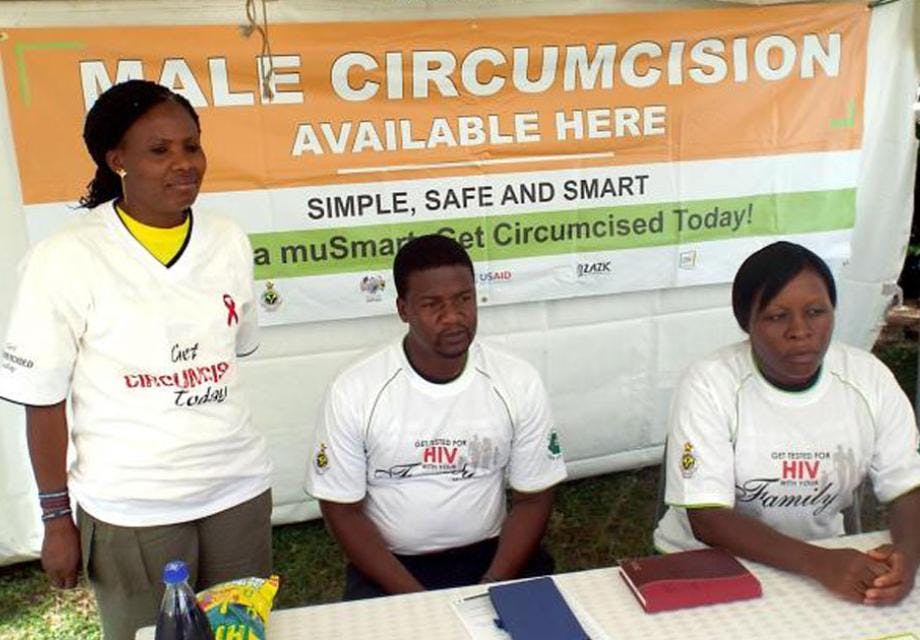Does Uganda need to realign its male circumcision campaign?
Avert staff writers
05 April 2016
Although more Ugandan men are seeking medical circumcision, the government is falling short of its 80 per cent target. This has led some health experts to ask if Uganda should adopt a new strategy to encourage more men to come forward.
By James Odong
There is silence inside a vehicle carrying a group of 14 men who have come to seek free voluntary male medical circumcision. The men, from Abeko village in the Eastern Ugandan district of Soroti, have come to be circumcised at Tiriri Health Centre. Among them is 38-year-old Alfred Eyatu, a father of five.
“I hope my manhood will not fail to erect after circumcision. I don’t know how my wife will react when I return home today. She has been telling me that if a man gets circumcised when he has a wife, he needs to first sleep with another woman, because sleeping with the wife first is a curse. She will not allow me to go and sleep with other women,” Eyatu complained.
Eyatu’s fears reflect myths about male medical circumcision in Uganda. Such myths can hamper efforts to encourage men to have the procedure.
National campaign
According to the World Health Organization (WHO) male circumcision reduces the risk of heterosexually acquired HIV infection in men by approximately 60 per cent. Uganda's National Policy on Safe Male Circumcision, developed in 2010, aimed to circumcise 80 per cent of men (4.2 million) aged 15-49 years by 2015. This is based on recommendations by the WHO and UNAIDS.
Although more Ugandan men are seeking medical circumcision, the government is falling short of its 80 per cent target. According to a report by the Uganda Aids Commission, 35 per cent of adult men had undergone safe medical circumcision by the end of 2014. This has led some health experts to ask if Uganda should adopt a new strategy to encourage more men to come forward.
One problem is a shortfall in funding. Dr Barbra Nanteza, coordinator of National Safe Male Circumcision from the Ministry of Health, said: “Our target for 2015 was one million but we had funding for only 330,000 procedures. That is a huge funding gap, which has slowed down the programme.”
Myths about circumcision
Medical experts also blame misconceptions about circumcision for its low uptake. Some men are put off by the time it will take for them to heal, while some women think it will lessen their partner’s sexual performance.
“Of course the most common fear is pain. People associate circumcision with men wearing skirts and walking with a staggering gait,” said Dr Joseph Etolu of Soroti Regional Referral Hospital. “But the wound heals quickly as long as it is cared for properly.”
He added: “There are also some cultural practices that may be harmful. Some believe it is a curse to have sex with your official wife after circumcision, so the first sexual encounter after the procedure should be with another partner. Others believe vaginal fluids are good for healing wounds, so they may have sex before they are properly healed.”
Some men also said that they did not see the value in medical male circumcision when they are advised to continue using condoms after the procedure.
“They tell you to circumcise and also use condoms: why?” said Felix Iputo, an uncircumcised man in Soroti Municipality. “This thing is not 100 per cent effective, so why don’t you just leave the circumcision thing and condomise?”
Cultural barriers
Male circumcision is traditionally practiced in a number of communities in Uganda. As well as Muslims getting circumcised for religious reasons, it is a rite of passage from childhood to adulthood among the Bagisu, an ethnic tribe in Eastern Uganda.
However, there are sometimes cultural barriers to medical male circumcision among these communities. Some tribes view taking the clinical approach as a sign of weakness because of the use of anaesthetic.
Another myth is that male circumcision is a way of ‘Islamising’ the population, according to Augustine Otella, health educator in Kumi District. Some people believe that proponents of circumcision want all people to convert to the Islamic faith.
Despite this, Dr Asaph Ssenoga, of Kibuli Muslim Hospital, said: “Nowadays we receive more non-Muslims than before seeking circumcision. I am sure that people are aware that this act is not only a religious or cultural act, but also a positive, healthy step in one’s life.”
Education is vital
According to a recent WHO report, Uganda has made good progress over the past two years, with over 1.7 million men circumcised in 2013 and 2014. Government campaigns have used provocative messages, including posters of women saying ‘I am proud I have a circumcised husband because we have less chances of getting HIV’. Reactions to these have been positive.
But as the campaign continues to scale up, the government must tailor its efforts to the unique needs of people who are most vulnerable to HIV infection. It must urgently address the funding gap to make sure men who want to have the procedure can do so.
Education is also vital to counter myths and misconceptions about the procedure. It should include educating women, so they support their partner’s decision to be circumcised and adhere to post-circumcision abstinence guidelines.
James Odong lives in Uganda and is a member of Key Correspondents, a citizen journalism network reporting for action on HIV. The network is supported by the International HIV/AIDS Alliance.
Get our news and blogs by email
Keep up-to-date with all our latest news stories and blogs by signing up to the Be in the KNOW news digest.
